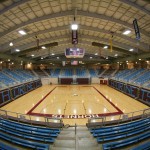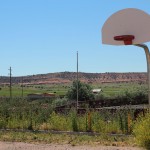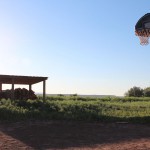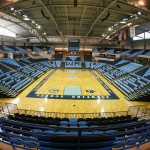Alicia Hale, a forward at Window Rock High School stepped up her training for senior year. (Photo by Chris Wimmer/Cronkite News)
The
Chinle Wildcat Den holds roughly 7,000 fans and has a VIP suite, a
media suit and custom locker rooms, among other features. (Photo by
Chris Wimmer/Cronkite News)
Ganado
Pavillion opened in 2003 and has a 5,800-seat capacity for a school of
just over 500 total students. (Photo by Chris Wimmer/Cronkite News)
An outdoor basketball hoop on a cracked concrete court at Ganado High School. (Photo by Chris Wimmer/Cronkite News)
Shane Yazzie, junior guard at Chinle High School, shooting baskets behind his house. (Photo by Chris Wimmer/Cronkite News)
Basketball hoop and dirt court behind Shane Yazzie’s house in Chinle. (Photo by Chris Wimmer/Cronkite News)
Window Rock High School’s Fighting Scouts Arena opened in 2014 and cost $50 million. (Photo by Chris Wimmer/Cronkite News)
By CHRIS WIMMER
Cronkite News
WINDOW ROCK — At 5:15 a.m., sunrise is only a thin pale highlight over red rock mesas in the east as Alicia Hale steps out of her house for her daily run. Even in June, the morning is so chilly at an altitude of almost 7,000 feet that she needs several layers to stay warm.
The Window Rock High School senior lines up next to her mother and younger sister in the dirt yard of their house in the capital of the Navajo Nation. They spread Navajo white corn powder on the ground in a quiet ceremony meant to offer thanks to the Creator for the blessings of life.
They exit the yard through a chain link gate and set out at an easy jog.
The peace and serenity of the early morning stand in stark contrast to the almost continual noise of big cities. There are no tractor-trailers rumbling down the roads to make pre-dawn deliveries. There is no thunder of machinery from construction sites where workers get an early start to beat the summer heat.
The only sounds at this hour are the roosters announcing the coming of a new day. They’re vocal and insistent — a soundtrack that could be considered jarring but that actually fits the environment. Instead of shattering the sublime atmosphere, their crowing enhances it.
Sixty miles to the northwest, in Chinle, the day progresses in similar fashion for Shane Yazzie, who will be a junior at Chinle High School in the fall. He runs, he does his chores and he practices basketball — he practices until he simply can’t anymore.
As the day draws to an end and the sun sets behind the equally picturesque mesas that frame the valley where Shane lives, he shoots baskets until the light is gone — and sometimes later. There are times when he plays so late that only shouts from his parents to come inside so they can sleep will force him to stop.
“If it’s raining, he’s out there in the mud. Rain, snow, or shine, he’s dribbling the ball outside and we don’t have the luxury of having a nice concrete court for him. It’s just dirt and an old basketball goal,” said Shane’s mother, Glendalyn.
Three small dogs yip and hop around his ankles at the beginning of a practice session, but soon they grow bored of the routine and lack of attention. They walk away in search of fun and frolic elsewhere, leaving him to drill jumpers by himself as the sunlight fades.
Shane practices on a dirt court behind his house. His pounding steps and incessant dribbling have killed off the weeds that inhabit the rest of the area. A patch of bare earth, pockmarked and uneven, has been left behind for him to hone his game.
If the ball sails through the tattered net with just the right amount of spin and lands at precisely the right angle on the dirt, it will pop back to him as if passed from an assistant.
These are the realities for many basketball players on the reservation. There are more homemade baskets and scratched-out practice surfaces than perfectly level paved driveways with store-bought adjustable hoops.
Things are different here. Connections to the Earth and community and family run deep here. All things are interwoven like threads in a tapestry.
Basketball has found itself tightly laced into that fabric. Fueled by what many Native Americans say is a natural love of running and competition, basketball is very nearly worshipped on reservations across the country.
“Basketball is almost a religion here,” said Pete Butler, the head coach of the girls’ team at Chinle High School.
On the Navajo reservation, it is the king of sports.
#
Basketball is the heart of the sports world on the Navajo reservation
in northeastern Arizona. All sports are represented, but basketball has
ascended to the throne. It stays there because the style of play unique
to reservation teams has captivated players and fans alike.Players sprint up and down the floor nonstop looking for the first good shot available. If they see it, they take it. They run until they wear the opposing team out. They run until they wear the referees out.
And then they keep running.
That is reservation basketball.
Wallace Youvella Jr., the athletic director and girls basketball coach at Hopi Junior/Senior High School, said he believes Native Americans have an instinctual love of running.
“In our culture, running is part of who we are. It comes very natural when you see our teams running up and down the court,” said Youvella.
That love led to an interest in cross-country and helped give birth to the style of basketball that was eventually nicknamed “rez ball.”
“Basketball is king on the reservation,” he said. “Not to take away from cross-country, but basketball is the most popular.”
Youvella doesn’t make his statement lightly. The boys cross-country program at Hopi Junior/Senior High School is unmatched by any other in the nation.
The National Federation of State High School Associations lists Hopi High School — officially known in the record book as Keams Canyon Hopi — as the winner of the most consecutive state titles in U.S. history.
“Right now, we’re in the works of getting a new banner put up because we ran out of space in the gymnasium for all those (individual) banners,” Youvella said, pointing at the blank white spaces around the top of the gym that are traditionally used to showcase athletic triumphs. “We had to stop in 2006 because we had no more room.”
Despite Hopi High School’s unprecedented success in cross-country, basketball is preferred above all other sports on the reservation, though many basketball players compete in both sports so they can maintain the incredible endurance required to be effective on the court.
In the traditional style of basketball, a team often jogs down the floor, sets up its half-court offense and runs plays out of various formations. The fast break is used to capitalize on opportunities when they present themselves during the game.
Rez ball is the opposite.
“They don’t really look at the clock as far as time, situation, score, et cetera. They just play,” said Raul Mendoza, head coach of the boys basketball team at Window Rock High School and a legend on the reservation after 38 years as a coach.
They run coordinated plays only if the first couple shot opportunities quickly dissolve and even then, the goal is to shoot the ball at the first open look at the basket.
“The feeling here is that the more passes you have, the more opportunities the defense has to unsettle your offense or for you to throw the ball away or for something bad to happen,” Youvella said. “So when you get that open shot, we encourage our players to take (it).”
The result is a high-octane show that is unique in the basketball world.
“Physically, they just wiped you out,” said former referee Terry Horning, who officiated summer tournaments on the reservation in the 1970s. “They never stopped running. The whole game was like a fast break.”
Horning traveled to 42 countries over the course of 10 years as the lead referee for the Harlem Globetrotters and said he never saw basketball played the way it is on the reservations.
“I started refereeing at the junior high school level and went all the way up through Division I college ball,” Horning said. “I worked the NBA Development League and I worked for the Globetrotters and in all of those games I never worked any harder than I did the two summers I went up and worked at those Native tournaments.”
Those tournaments on the Navajo reservation were in the summers of 1973 and 1974. Horning and two other referees were recruited from Phoenix to drive up to the reservation and officiate games over a weekend.
After a long Saturday of games, they could barely crawl into their beds. By the time the tournament ended on Sunday afternoon Horning said the officials were completely “spent.”
More than 40 years later, the style of basketball is still nearly identical. The No. 1 tenet is the same: run.
To build the stamina needed to maintain that demanding tempo for an entire game, kids run countless miles on the trails and dirt roads that wind through the hills and canyons on the reservation. And many of them participate in cross-country as well as basketball.
Alicia Hale’s 5:15 a.m. regimen, six days a week, currently has her running 3 miles per day but this summer she has stepped up her training and commitment to basketball and 3 miles will not be enough for much longer.
“By the end of the summer, I want to be running 5 to 6 miles each morning,” she said.
As a part of that intensified training program, she is challenging herself in the weight room like never before, under the guidance of Mendoza.
“She’s highly motivated. She wants to get better,” Mendoza said. “She’s open to learning and she pushes herself.”
She hopes the extra work will help cut down on the knee and ankle sprains that nagged her last year as well as prepare her for her all-important senior year. The breakneck pace of play is punishing and she needs to be ready.
“Rez basketball is a very high-paced, very talented, intense form of basketball that I don’t care who you are, you’re going to enjoy watching it,” said Harold Slemmer, the executive director of the Arizona Interscholastic Association.
Fans on the reservations don’t just enjoy watching it. They love it. They live it.
#
“Chaos, just chaos” is how Window Rock High School senior center
Branon Chickaway describes the fans during basketball season. He will be
one of Mendoza’s co-captains next year and he likes the chaos.He fell in love with basketball at a young age when his maternal grandparents took him to a game at the old Veteran’s Memorial Field House, where almost 2,000 screaming fans were packed into every corner of available space.
But 2,000 fans is nothing compared to the 6,500-seat capacity of the new Window Rock Fighting Scouts Event Center where Chickaway began playing his games in 2014.
A four-sided electronic scoreboard hangs over the immaculate floor. There is a VIP area in one corner of the second level with a long conference table and plush leather office chairs, though at least one past president of the Navajo Nation was known to eschew the space typically reserved for dignitaries in favor of courtside seats to be close to the action.
There is a bay for the media with two rows of seats and tabletops for computers. There are six concession stands in the corridors. There are boys’ and girls’ dressing rooms with the Window Rock Fighting Scout logo stitched into the carpet, cherry wood lockers for each player, and chairs with the mascot emblazoned on the leather-cushioned seats.
In short, it’s a professional setup — on a smaller scale — for a school with an enrollment of roughly 700 students.
The arena provides one of the largest home-court advantages in the state of Arizona for a high school basketball game.
That kind of arena is not exclusive to Window Rock. Similar venues exist in Chinle, Ganado, Monument Valley and Tuba City.
By comparison, the largest school in the state, Hamilton High School in Chandler, with approximately 3,500 students, plays its home games in a school gymnasium that holds roughly 4,000 people.
The arenas on the reservations were built at such a large scale for one primary reason: The fans have proven they will come.
They fiercely support their teams regardless of the win-loss record. Their enthusiasm and volume can sometimes make it hard for players and coaches to communicate during a game. They are willing to wait in line for hours, and even overnight, for tickets.
Ganado High School Athletic Director Jim Dowse remembered a game his school played against Chinle: “For a Saturday game, people would spend the night (outside the arena) on Friday. And this is in January up here. It could be 10 degrees at night. That’s not uncommon. Grandma’s out there with the extension cord to the electric blanket. Crazy, just crazy.”
For big games, and especially state tournament games, communities on the reservation rally around their schools.
“Teachers stop teaching and everyone goes outside to stand in a parade line when the team goes down to Phoenix for state,” said Casey Johnson, the new coach of the Chinle boys basketball team. “Everybody’s right there waiting for one bus to go by.”
At 30 years old, Johnson is a young head coach and a product of reservation basketball. He played in the youth leagues on the Navajo reservation when he was a child and then at Tuba City High School before finishing his playing career at Haskell Indian Nations University in Kansas.
Basketball has been his life.
“It’s very important to us. I believe it’s in our DNA to be competitive. It’s natural. We’re very competitive people,” he said.
#
The combination of a competitive nature and extreme fanaticism can
put immense pressure on and foster high expectations for players who are
only teenagers.Branon Chickaway and Shane Yazzie love playing in front of legions of screaming fans. They thrive on it. But others admit it can be difficult.
“You may win two straight state championships and the community is waiting for that third,” said Pete Butler, the Chinle girls basketball coach, though he still relishes the job of coaching at a high-profile school.
One of his up-and-coming stars, Amanda Antone, said she was nervous and scared to make a mistake during her first game in front of so many fans at the 6,000-seat Chinle Wildcat Den.
“They try to control you on the court even though they’re in the stands,” she said.
Mendoza has coached at four schools in his career, including two separate stints at Window Rock and two at Holbrook High School. He has heard similar concerns from his players over the years.
“Some kids told me that it’s no fun to play because there’s so much pressure. A lot was expected of them. I think the fans really expect a lot out of the kids,” he said.
Despite the high expectations and the near-constant bellowing from the crowd to shoot the ball, Amanda said she got used to the noise after that first game and now wouldn’t trade the passion of the fans for any of the possible negatives.
She will only be a sophomore this fall, but the desire to play the game already outweighs the demands that will be placed on her by the vocal fan base when the season starts.
“I love the sport and I can’t go a day without it. I have to have that ball in my hand in order for me to think straight,” she said.
#
“It’s my passion. I love to play basketball,” said Yazzie. “Even when
I don’t have a basketball in my hand, I still imagine that there’s one
there, and a lot of kids are like that around the reservation.”Shane and Amanda — two kids with nearly identical thoughts. They are separated by two years at Chinle High School but have the same yearning for the game.
On the reservation, that yearning goes beyond the natural love of running mentioned by Youvella. It goes beyond the competitive instincts that Johnson believes are ingrained in the Navajo people.
For many players, sanctuary is at the center of their love of basketball.
“Basketball is an escape,” said Mendoza. “It helps them fill something in their lives that might be missing — to fill a void, I guess you could say.”
The kids can step onto the hardwood courts of the huge arenas or the dirt lots behind their homes and tune out some of the realities of the reservation.
There are few options for entertainment, so the communities navigate toward sports for enjoyment and distraction, and to dodge the pitfalls that can creep into the void.
“If it wasn’t for basketball, or any of the sports that we have, I think that a lot of our kids would go astray and turn to drugs and alcohol and other bad things that they encounter,” said Shane Yazzie’s mother, Glendalyn.
Parents use discipline, traditions and a deep-rooted understanding of their values to instill self respect and respect for the community in their kids to help them avoid the “bad influences” that can lurk in places with limited opportunities.
Alicia Hale counts those values on her fingers as quickly and easily as if she were reciting the first five letters of the alphabet: faith, family, school, sports and friends — in that order.
“When I step on that court, I feel like there’s a lot of people watching me. They watch to see what you do and how you do it — how you present yourself on and off the court,” she said.
Yazzie also understands his behavior will be scrutinized.
“If you play basketball, you represent your school, your team, your family, your clans and your community. Your community looks up to you,” he said.
Branon Chickaway’s grandfather, Gabriel Haskie, used an ancient ceremony to help Branon begin to walk on the correct path. When Branon was 12, Haskie took him into a sweat lodge to pray.
“This is how our ancestors, how our great elders taught us,” said Haskie. “We encourage the young ones to go on with life in a positive way, to learn something about themselves, about their lives, to be the people that they should be.”
Those instructions have taken hold and are displayed when Native teams compete in Phoenix during the state tournament. The Arizona Interscholastic Association oversees the competition, and its director says he has seen the fruits of the labor of parents and coaches on the reservation.
“The competitive culture there is just different,” Slemmer said. “It’s very positive. Very, very seldom do we ever see anything that would even resemble (poor) sportsmanship. They’re extremely good sportsmen and sportswomen. They’re very supportive of each other.”
The commitment to sportsmanship isn’t a new phenomenon. Horning, the former referee, had the same the experience more than 40 years ago.
“They’re very good about sportsmanship,” he said. “That was one of the refreshing parts of it. I worked those tournaments for two years and I guarantee you I never even thought about calling a technical foul.”
#
Glendalyn and Shawn Yazzie made it very clear to their son Shane that without the grades, there is no basketball.“We make his education the priority, then his sport,” said Shawn.
Shane saw the lesson firsthand when his father told one of his older brothers he was no longer allowed to play because his grades had begun to suffer. Shane has no intention of jeopardizing his career.
“It gives me motivation in school to keep my grades up,” he said.
In addition to using strict discipline and a deep appreciation of their values to guide their kids, parents and coaches emphasize that education is the driving force behind success on and off the court.
“I try to stress to the kids, your education is more important,” said Mendoza. “That’s what’s going to allow you to get opportunities in life, to get jobs, to go better yourself.”
Vernon and Clarissa Hale say they’ve never had to worry about Alicia’s performance in the classroom. She has been on the National Honor Society every year and the benefits and importance of a quality education are consistently at the forefront of her thoughts.
“If you’re a star basketball player, you have to have the education to go with it,” Alicia said. “My No. 1 goal with basketball is to be able to play at the next level, whether it’s (junior college), community college, Division I, II or III. That’s fine with me. As long as I get to come back here to use the education that I get.”
Alicia has one more year to prove herself on and off the court. Like many others on the reservation, she’ll play in summer leagues hosted by her high school.
She’ll play on club teams and AAU teams in tournaments across Arizona to showcase her talents with the hope of earning the college scholarship she wants so badly.
Finally, as fall turns to winter, she’ll jog onto the court again in front of thousands of screaming fans who have arrived from all corners of the Navajo Nation to watch the sport they love.
The fans will reconnect with distant friends and relatives from different parts of the reservation and shout for the kids to “shoot! shoot! shoot!”
It will also be Branon Chickaway’s final year on the floor of the Window Rock Fighting Scouts Arena. His grandparents — who have raised him — had six children of their own and survived years of travel and expense as they watched their kids play every sport possible.
So, as Branon grew — he’s 6 feet 2 inches tall now — his grandfather, Gabe Haskie, knew what would come next.
As he thinks back and retells the story of his reaction to Branon’s announcement that he wanted to play basketball like his aunts and uncles, he nudges his straw cowboy hat back a little further on his head.
“‘Good,’” Haskie told his grandson.
Then he pauses, looks down and takes a deep breath, mimicking the moment he and his wife committed to several more years on the road to the arenas of the Navajo Nation. When he looks up, there’s thin smile on his lips and a bright light in his eyes.
“Guess we better saddle our horses again.”















No comments:
Post a Comment